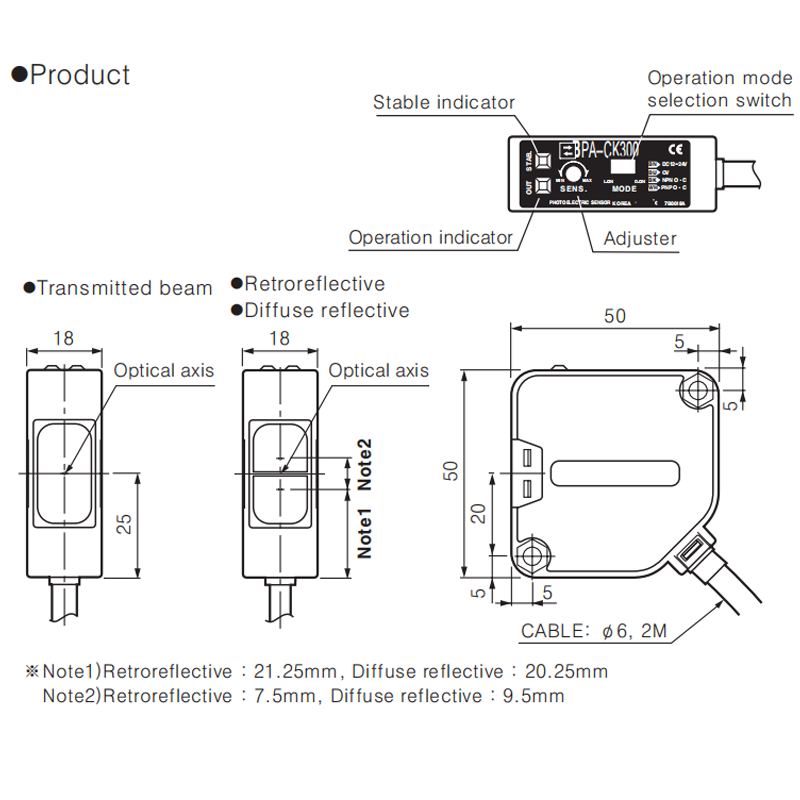Modern automation systems demand precise, reliable detection capabilities that can operate effectively across diverse industrial environments. A photoelectric sensor represents one of the most versatile and dependable solutions for detecting objects, measuring distances, and ensuring safety in automated processes. These sophisticated devices utilize light beams to detect the presence, absence, or characteristics of objects without physical contact, making them indispensable components in contemporary manufacturing, packaging, and material handling operations.
The evolution of industrial automation has created an increasing need for sensors that can provide accurate feedback while withstanding harsh operating conditions. Photoelectric sensors excel in this regard, offering exceptional flexibility in detecting various materials including metals, plastics, glass, liquids, and even transparent objects. Their non-contact operation eliminates wear and mechanical failure concerns, while their rapid response times enable high-speed applications that traditional mechanical switches cannot accommodate.
Fundamental Operating Principles
Light Emission and Detection Technology
Photoelectric sensors operate on the fundamental principle of light transmission and reception, utilizing either visible light or infrared radiation to perform detection functions. The sensing system consists of a light source, typically an LED or laser diode, and a photodetector that responds to changes in light intensity. When an object interrupts or reflects the light beam, the photodetector generates an electrical signal that triggers the sensor output.
The light source selection significantly impacts sensor performance characteristics. Infrared light sources provide excellent penetration through dust and moisture, making them ideal for harsh industrial environments. Visible red light sources offer easier beam alignment and troubleshooting capabilities, while laser sources deliver precise, focused beams for small object detection and long-range applications.
Signal Processing and Output Generation
Advanced photoelectric sensors incorporate sophisticated signal processing circuits that analyze received light intensity and convert optical signals into reliable electrical outputs. These circuits include amplification stages, filtering components, and threshold detection systems that ensure consistent performance despite environmental variations. Many modern sensors feature automatic gain control and background suppression capabilities that maintain stable operation across changing conditions.
Output configurations vary according to application requirements, with options including NPN, PNP, relay contacts, and analog signals. Digital outputs provide discrete on/off switching for binary detection applications, while analog outputs enable precise distance measurements and position monitoring. Some sensors offer programmable switching points and delays that allow customization for specific application needs.

Configuration Types and Applications
Through-Beam Sensing Systems
Through-beam configurations represent the most reliable photoelectric sensing method, featuring separate transmitter and receiver units positioned opposite each other. This arrangement provides maximum sensing range and excellent immunity to ambient light interference. When an object passes between the transmitter and receiver, it interrupts the light beam and triggers the sensor output.
Manufacturing applications frequently utilize through-beam sensors for counting products on conveyor systems, detecting broken or missing components, and monitoring material flow. Their ability to detect transparent and translucent objects makes them particularly valuable in packaging operations where glass containers, plastic films, and clear materials require reliable detection.
Retro-Reflective Detection Methods
Retro-reflective sensors combine the transmitter and receiver in a single housing while utilizing a reflector positioned opposite the sensor. The light beam travels from the sensor to the reflector and returns to the receiver, creating a sensing zone between the sensor and reflector. Object detection occurs when something interrupts this reflected light path.
This configuration offers excellent detection capabilities for most opaque objects while requiring only one-sided installation access. Retro-reflective sensors prove particularly effective in applications involving large objects, irregular shapes, and situations where through-beam installation is impractical. Advanced models incorporate polarized light filters that enable detection of reflective objects that might otherwise be invisible to standard retro-reflective sensors.
Diffuse Reflection Sensing
Diffuse reflection sensors detect objects by measuring light reflected directly from the target surface back to the sensor. This self-contained approach requires no additional components or opposite-side access, making installation simple and economical. Detection range varies according to object surface characteristics, with light-colored and reflective surfaces providing greater range than dark or matte surfaces.
Background suppression technology enhances diffuse sensor performance by establishing a fixed detection range regardless of object reflectivity. This capability proves essential in applications where consistent detection distance is critical, such as robotic pick-and-place operations or automated sorting systems.
Performance Advantages in Industrial Applications
Speed and Response Characteristics
Modern photoelectric sensors deliver exceptional response speeds, with switching frequencies reaching several kilohertz in high-performance models. This rapid response capability enables detection of fast-moving objects on high-speed production lines, automated packaging equipment, and robotic systems. The absence of mechanical switching elements eliminates bounce and delay issues associated with traditional mechanical sensors.
Response time consistency remains stable across the sensor's operational lifetime, unlike mechanical switches that may develop timing variations due to wear. This reliability ensures predictable system performance and maintains synchronization in complex automated sequences where precise timing is critical.
Environmental Resilience and Durability
Industrial photoelectric sensor designs incorporate robust construction techniques and protective features that enable operation in challenging environments. Sealed housings with IP67 or IP68 ratings provide protection against dust, moisture, and chemical exposure, while shock and vibration resistance ensure reliable operation on moving machinery.
Temperature compensation circuits maintain stable performance across wide temperature ranges, typically from -40°C to +70°C or higher. This thermal stability prevents drift and false triggering that could compromise system reliability. Many sensors also feature built-in surge protection and electromagnetic compatibility measures that ensure proper operation in electrically noisy industrial environments.
Selection Criteria and Technical Considerations
Range and Detection Requirements
Selecting the appropriate photoelectric sensor requires careful analysis of detection range requirements, object characteristics, and environmental conditions. Through-beam sensors offer the longest range capabilities, often exceeding 50 meters in clear conditions, while diffuse sensors typically operate within shorter ranges suited to proximity detection applications.
Object size, shape, surface finish, and material properties significantly influence sensor selection. Small objects require focused beam sensors with high resolution, while large objects may benefit from wide-beam sensors that provide more forgiving alignment tolerances. Transparent and translucent materials often require specialized sensors with enhanced sensitivity or specific wavelength characteristics.
Installation and Alignment Considerations
Proper installation and alignment ensure optimal photoelectric sensor performance and longevity. Mechanical mounting systems must provide stable positioning while allowing for thermal expansion and operational vibrations. Electrical connections require appropriate cable routing and protection to prevent interference and mechanical damage.
Optical alignment becomes critical for through-beam and retro-reflective configurations, with many sensors offering visual alignment aids such as LED indicators or laser pointers. Maintenance access should be considered during installation planning to facilitate periodic cleaning of optical surfaces and verification of alignment accuracy.
Integration with Control Systems
Interface Compatibility and Signal Types
Modern photoelectric sensors offer diverse interface options that accommodate various control system architectures. Standard discrete outputs include NPN and PNP transistor types that interface directly with PLC input modules, while relay outputs provide galvanic isolation for applications requiring electrical separation between sensor and control circuits.
Advanced sensors incorporate analog outputs that provide proportional signals representing distance, light intensity, or other measured parameters. These analog capabilities enable closed-loop control applications such as web guiding, edge detection, and precise positioning systems. Some models offer dual outputs that combine discrete switching with analog measurement capabilities.
Network Integration and Smart Sensor Features
Industrial communication protocols enable photoelectric sensors to integrate seamlessly with networked control systems. DeviceNet, Profibus, Ethernet/IP, and other fieldbus protocols allow sensors to transmit detailed diagnostic information, parameter settings, and measurement data to central control systems.
Smart sensor features include self-diagnostic capabilities that monitor operational parameters and provide early warning of potential failures. Remote parameter adjustment allows operators to modify sensitivity, delays, and switching points without physical access to the sensor location. These capabilities reduce maintenance requirements and enable predictive maintenance strategies that minimize unexpected downtime.
FAQ
What factors affect photoelectric sensor detection range?
Detection range depends on several factors including sensor type, object reflectivity, ambient light conditions, and environmental factors such as dust or moisture. Through-beam sensors provide the longest range, while diffuse sensors vary significantly based on target surface characteristics. Dark objects reduce detection range, while highly reflective surfaces may extend range beyond specifications.
How do photoelectric sensors handle transparent materials?
Detecting transparent materials requires specialized sensor configurations and techniques. Through-beam sensors work best for clear materials as they detect light beam interruption rather than reflection. Some sensors use polarized filters or specific wavelengths optimized for glass detection. Background suppression sensors can also detect transparent objects by measuring light refraction effects.
What maintenance do photoelectric sensors require?
Regular maintenance involves cleaning optical surfaces to remove dust, oil, or other contaminants that could affect performance. Periodic alignment verification ensures optimal sensitivity, especially for through-beam configurations. Electrical connections should be inspected for corrosion or looseness. Many modern sensors provide diagnostic outputs that indicate when cleaning or maintenance is needed.
Can photoelectric sensors operate in harsh industrial environments?
Yes, industrial-grade photoelectric sensors are designed for harsh environments with appropriate IP ratings for dust and moisture protection. Temperature-compensated designs maintain performance across wide temperature ranges, while robust housings resist shock and vibration. Specialized models handle chemical exposure, explosive atmospheres, and extreme temperatures through appropriate certifications and construction materials.

